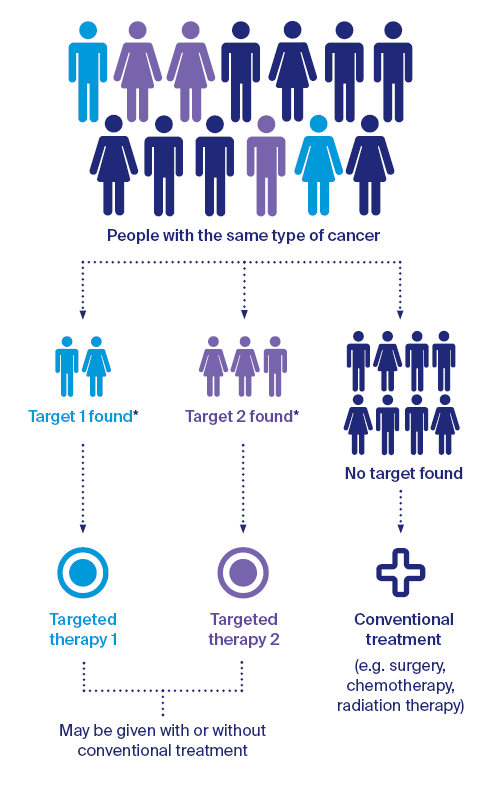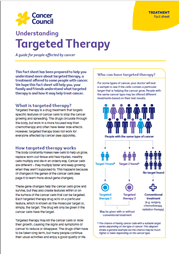- Home
- About Cancer
- Cancer treatment
- Targeted therapy
- What is targeted therapy?
What is targeted therapy?
Targeted therapy is a drug treatment that targets specific features of cancer cells to stop the cancer growing and spreading. The drugs circulate through the body, but work in a more focused way than chemotherapy and often have fewer side effects. However, targeted therapy does not work for everyone affected by cancer.
Learn more about:
- How targeted therapy works
- Who can have targeted therapy?
- How cancer is treated
- How is targeted therapy different to chemotherapy?
- When is targeted therapy used?
- Video: What is targeted therapy?
How targeted therapy works
The body constantly makes new cells to help us grow, replace worn-out tissue and heal injuries. Healthy cells multiply and die in an orderly way. Cancer cells are different – they multiply faster and keep growing when they aren’t supposed to. This happens because of changes in the genes of the cancer cells (learn more about gene changes).
These gene changes help the cancer cells grow and survive, but they also create features within or on the surface of the cancer cells that can be targeted. Each targeted therapy drug acts on a particular feature, which is known as the molecular target or, simply, the target. The drug will only be given if the cancer cells have the target.
Targeted therapy may kill the cancer cells or slow their growth, causing the signs and symptoms of cancer to reduce or disappear. The drugs often have to be taken long term but many people continue their usual activities and enjoy a good quality of life.
When I was first diagnosed with chronic myeloid leukaemia, I was put on imatinib. I had severe side effects, so my haematologist put me on dasatinib. I’ve been on this for over eight years with excellent results. As the leukaemia is still detected in blood tests, there’s no plan to discontinue the treatment.
Patricia
Who can have targeted therapy?
For some types of cancer, your doctor will test a sample to see if the cells contain a particular target that is helping the cancer grow. People with the same cancer type may be offered different treatments based on their test results.

*The chance of having cancer cells with a suitable target varies depending on the type of cancer. This diagram shows a general example but the chance may be much higher or lower depending on the cancer type.
How cancer is treated
Because each cancer is unique, people may have different treatment plans, even if their cancer type is the same.
The three main cancer treatments are:
- surgery
- chemotherapy
- radiation therapy (also called radiotherapy).
Other treatments used for some types of cancer in some people include:
- targeted therapy
- immunotherapy
- hormone therapy.
Chemotherapy, targeted therapy, immunotherapy and hormone therapy are all drug therapies. They are known as systemic treatment because the drugs circulate throughout the body.
Cancer treatments may be used on their own or in combination. For example, you may have surgery to remove a tumour, followed by targeted therapy to stop the cancer returning. Sometimes targeted therapy is combined with chemotherapy.
Doctors will recommend the best treatment for you based on the type and stage of cancer, its genetic make-up, your age and your general health.
To learn more about other treatments, see our sections on surgery, chemotherapy, radiation therapy and immunotherapy.
How is targeted therapy different to chemotherapy?
Chemotherapy drugs affect all cells that multiply quickly. This means the drugs can kill cancer cells and also damage other cells that multiply quickly, such as healthy cells in the mouth, stomach, bone marrow or hair.
This is why chemotherapy side effects often include mouth ulcers, nausea, low numbers of blood cells (leading to infections or anaemia) and hair loss.
Targeted therapy drugs work in a different way. They focus on the cancer cells, while limiting damage to healthy cells. Many people experience fewer side effects with targeted therapy, but it can still cause various side effects. Sometimes these can be serious.
When is targeted therapy used?
Using targeted therapy to treat cancer has improved survival rates for several types of cancer, and many people respond well. However, targeted therapy is not an option for everyone with cancer.
In Australia, targeted therapy drugs are now available for a range of cancers, including blood cancers such as leukaemia and lymphoma; common cancers such as bowel, breast, lung and melanoma; and other cancers such as cervical, head and neck, kidney, liver, ovarian, pancreatic, sarcoma, stomach and thyroid. For most of these cancers, targeted therapy is available only when the cancer is advanced. For some types, it is also available for early-stage cancer.
These are the main types of targeted therapy, but new drugs are becoming available every year, so talk to your doctor about the latest options.
Targeted therapy may be used:
- before surgery to reduce the size of a cancer (neoadjuvant therapy)
- after surgery to destroy any remaining cancer cells (adjuvant therapy)
- to treat cancer after initial treatments if the cancer has come back or hasn’t responded to other treatments (second-line therapy or palliative treatment)
- as long-term treatment to try to prevent the cancer coming back or control its growth (maintenance treatment).
Many targeted therapy drugs are not safe to use during pregnancy or while breastfeeding. Ask your doctor for advice about contraception. If you become pregnant, let your medical team know immediately.
Video: What is targeted therapy?
Watch this short video to learn more about drug therapies, including targeted therapy and immunotherapy.
Podcast: Immunotherapy & Targeted Therapy
Listen now
More resources
This information was reviewed by: A/Prof Brett Hughes, Senior Staff Specialist, Medical Oncology, Royal Brisbane and Women’s Hospital and The Prince Charles Hospital, and The University of Queensland, QLD; Natalie Dubs, Consumer; Hazel Everett, Clinical Nurse Consultant, Cancer Services, St John of God Subiaco Hospital, WA; Karen Hall, 13 11 20 Consultant, Cancer Council SA; Dr Hilda High, Genetic Oncologist, Sydney Cancer Genetics, NSW; Ingrid Kivikoski, Consumer; Anne McGregor, Consumer; Donna Milne, Nurse Consultant, Melanoma and Skin Service, Peter MacCallum Cancer Centre, VIC; Prof Nick Pavlakis, Board Chair, Thoracic Oncology Group of Australasia (TOGA), and Senior Staff Specialist, Department of Medical Oncology, Royal North Shore Hospital, NSW; Gay Refeld, Clinical Nurse Consultant, Breast Care, St John of God Subiaco Hospital, WA.
View the Cancer Council NSW editorial policy.
View all publications or call 13 11 20 for free printed copies.
Need to talk?
Support services
Coping with cancer?
Ask a health professional or someone who’s been there, or find a support group or forum
Need legal and financial assistance?
Pro bono legal and financial matters, no interest loans or help with small business
Cancer information
Dealing with the diagnosis
Common reactions to a cancer diagnosis and how to find hope
View our publications
Guides and fact sheets for people with cancer, their families and friends


